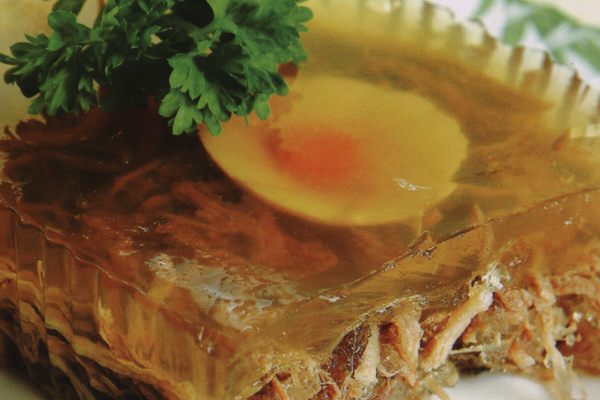Residents of Alaska and Canada’s northern-most regions are no strangers to moose meat. In such climes, moose meat is eaten in the form of steaks, sausages, and even pizza topping. One moose dish, however, remains a rare delicacy: jellied moose nose.
In the past, indigenous hunters in the greater Northwest could rely on one whole moose to feed a family for weeks. Every part of the animal was eaten or preserved, including the nose. The moose’s long, bulbous snout is still considered a delicacy among indigenous communities. Jellied moose nose is similar to European head cheese, trapping cuts of moose nose within a gelatinized broth. The dish was even mentioned in the Northern Cookbook, a 1967 publication by the Canadian government that offered recipes and cooking advice for “wilderness wives” living in the backwoods of the far north.
A moose’s nose contains both white meat (from the bulb of the nose) and dark meat (from around the bones). The fur must be removed prior to cooking, either by being singed off over an open fire, peeled off after the nose has been boiled, or simply skinning the nose. Chefs then slice the nose and simmer it with onions, garlic, and an array of other spices, which may include cinnamon, cloves, allspice, or mustard seeds. Meat from other parts of the moose’s head, such as the ears and lips, may be added to the mix. Once the concoction has cooled down, the cook lays the pieces of meat in a loaf pan, douses them with broth, and places the mixture in the refrigerator so the broth can solidify. The resulting jelly is served like a loaf of bread and eaten in slices.
Moose meat tends to be lean and gamey; jellied moose nose, however, is more complex. Chef Andrew Zimmern described the dish as exploding “with little tastes,” likening the flavor to corned beef. When different cuts from the moose head are mixed together, the jelly sports a variety of textures, from the chewiness of nose cartilage to the tenderness of cheek meat.
Written By
 Tatiana Harkiolakis
Tatiana Harkiolakis
Sources
- www.dailymotion.com/video/x28vpa6
- www.cbc.ca/news/canada/north/how-to-prepare-moose-nose-the-gwich-in-way-1.2926713
- gluttodigest.com/alaskan-foods/
- books.google.gr/books?id=ir3CCQAAQBAJ&pg=PT113&lpg=PT113&dq=jellied+moose+nose+taste&source=bl&ots=SAPGyduNtM&sig=3Uz31Cy_87SZLzEl51uhLNt0XP0&hl=en&sa=X&ved=0ahUKEwjp1MDTjv7bAhVCiKYKHQ1mCMA4FBDoAQg-MAU#v=onepage&q=jellied%20moose%20nose%20taste&f=false
- www.nativevillage.org/Messages%20from%20the%20People/canadian_north_cookbook______exc.htm
- www.epicurious.com/archive/blogs/editor/2011/11/moose-and-other-alaskan-delights.html
- bertc.com/subfive/recipes/household.htm
- books.google.gr/books?id=eu5lqH8JU4YC&pg=PT127&lpg=PT127&dq=moose+muffle+jelly&source=bl&ots=joOsFKVRab&sig=lIvRITbuwdqw6uiNLbkkuvth8GI&hl=en&sa=X&ved=0ahUKEwjbtb3KzYDcAhXR-aQKHY_sCdQQ6AEIPzAD#v=onepage&q=moose%20muffle%20jelly&f=false
The Atlas Obscura Podcast is Back!














